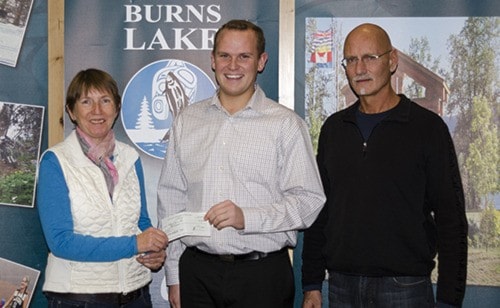On Nov. 7 Dan Boudreau, Manager of the Nechako-Kitamaat Development Fund (NKDF) held a public meeting to get input from community stakeholders regarding future funding strategies.
The NKDF was established in 1999 in a settlement the province made with
Rio Tinto Alcan (RTA) where the province and RTA both invested $7.5 million into a fund designed to sustain economic activity in the watershed region affected by the flooding of the Nechako Reservoir.
The NKDF currently has $15 million in a legacy portion of the fund as well as $1.5 million on working or grant capital. It has approved over $7.2 million in grant applications and funded over 220 projects averaging $557,488 in funding every year.
Some high profile recent projects that the NKDF has helped to support throughout the region have been the Burns Lake Mountain Bike Park and trail system, the Fraser Lake wharf, the Southside commercial development project in Fraser Lake and the Nechako View Senior Citizens Home Society in Vanderhoof.
Boudreau described some of the funds legislated limitations. It can invest in community economic development projects or programs supported by the community, but it cannot provide funds to a private, for profit business. NKDF was established to fund infrastructure, planning and research, human development and promotion. It was not, Boudreau explained, established to provide long term and ongoing operating funds, like wages, for projects
Boudreau explained to stakeholders that NKDF could play a crucial role in helping community level initiatives move from financial instability to self-sustainability through the granting of ‘incremental’ funds to cover short term start up expenses. These incremental funds could cover operational expenses, as long as it was understood that this funds could not be considered part of the long term economic model of the project.
Logan Wilson, Recreation Director for the Village of Burns Lake, was at the meeting as a concerned stakeholder. He described how a grant designed to meet the initial operational, or incremental, costs associated with an infrastructure project could be as important as the infrastructure itself.
“It’s great that funds are there to build a new facility,” he said, “but if funds aren’t available to allow you to run that facility so that people can begin to change their lifestyle habits it won’t do the community any good.”
Another participant in the discussion Judy French, Social Development Officer with the Burns Lake Band, said that it’s a lot easier to find money for economic or business ventures than it is to find funds for social projects like a daycare, gymnasium or park.
“The government classifies those [kinds of projects] as operational,” said French, and it is difficult to find money for projects like that. But those projects that are difficult to find funding for may be the most important to a community.
While NKDF does not provide operational funds, French pointed out that NKDF wouldn’t necessarily be asked to fund an operation continually for a year, but just long enough for it to become self-sustainable and viable on its own. “Project funding for three months or less might help us to generate a revenue so that we can sustain ourselves,” she said.
Lynn Synotte, President of the Lakes Outdoor Recreation Society pointed out that funds were needed to maintain the investments, both financial and volunteer, that have been put into trail development in the area.
Boudreau explained that there is flexibility within NKDF for what he described as ‘incremental’ funding requirements. Although NKDF cannot provide operational funds it can provide funding to short term projects to get them off the ground.
The meeting then turned to future projects that NKDF might be involved with locally. Upgrades to the municipal campgrounds by the Y2K Skateboard park, continued investment in the maintenance and upgrade of community halls, downtown sprucing up as well as long-term initiatives like raising the profile of the John Baker Airport so that it eventually might attract a regional carrier were all floated during the session.
Joan McFee, a volunteer with the Francois Lake Hall said that she was concerned that volunteer burnout would eventually take its toll throughout the community if funds couldn’t be found to help support the operation of the many facilities that have been developed over the years.
A further significant problem that came up during the meeting, involved changes introduced with the province’s move to a harmonized sales tax (HST). Previously, non-profit groups were able to have the GST portion of their costs reimbursed, but with the introduction of the HST, they lost that reimbursement. The increased tax burden on projects has led to some local organizations having had to reconsider the feasibility of a project even though they have funding available.
Kevin Derksen, president of the Burns Lake Mountain Biking Association, described situations where the new tax burden of a project has meant that they have had to scale back on what they could do. The HST has not only affected the purchasing power of NKDF funds, but the tax is also applicable to labour cost. Where groups benefitting from the fund used to be able to count on a reimbursement of the GST paid on labour and goods, they can no longer count on that.
Despite the difficulties involved with carefully managing NKDF funded projects, all participants agree that those difficulties do seem to stem from its great success within communities. Having facilities that need volunteers or incremental funding is a better challenge than not having facilities at all.
McFee, who also volunteers her time with the Lakes District Fall Fair and Music Festival, described how the event has grown more successful through the support of the NKDF. It used to average 700 visitors over a weekend, but grew to 1,500 visitors in its first year of NKDF funding and was up to 2200 visitors over the weekend in its second year of funding.
